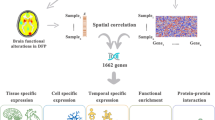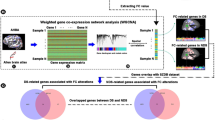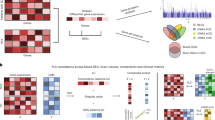Abstract
DTNBP1 (dysbindin) is one of the several putative schizophrenia genes supported by association, neuroanatomical, and cellular studies. These suggest an involvement of DTNBP1 in the prefrontal cortex and cognitive functions mediated by interaction with neurotransmitter systems, in particular glutamate. The influence of DTNBP1 gene variation on prefrontal brain function at the systemic neurophysiological level, though, has not been characterized. The NoGo-anteriorization (NGA) as an event-related potential (ERP) measure elicited during the continuous performance test (CPT) has been established as a valid neurophysiological parameter for prefrontal brain function in healthy individuals and patients with schizophrenias. In the present study, we therefore investigated the influence of eight dysbindin gene variants on the NGA as a marker of prefrontal brain function in 48 healthy individuals. Two DTNBP1 polymorphisms previously linked to schizophrenia (P1765 and P1320) were found associated with changes in the NGA. Post hoc analysis showing an influence of genetic variation at these loci on the Go centroid and frontal amplitudes suggest that this might be due to modification of the execution of motor processes by the prefrontal cortex. This is the first report on a role of DTNBP1 gene variation for prefrontal brain function at a systemic neurophysiological level in healthy humans. Future studies will have to address the relevance of this observation for patients with schizophrenias.
Similar content being viewed by others
Log in or create a free account to read this content
Gain free access to this article, as well as selected content from this journal and more on nature.com
or
References
Berg D, Herrmann M, Müller ThJ, Strik WK, Aranda D, Koenig Th et al (2001). Cognitive response control in writer's cramp. Eur J Neurology 8: 587–594.
Canli T, Omura K, Haas BW, Fallgatter A, Constable RT, Lesch KP (2005). Beyond affect: a role for genetic variation of the serotonin transporter in neural activation during a cognitive attention task. Proc Natl Acad Sci USA 102: 12224–12229.
Caspi A, Sugden K, Moffitt TE, Taylor A, Craig IW, Harrington H et al (2003). Influence of life stress on depression: moderation by a polymorphism in the 5-HTT gene. Science 301: 386–390.
Egan MF, Goldberg TE, Kolachana BS, Callicot JH, Mazzanti CM, Straub RE et al (2001). Effect of COMT Val108/158 Met genotype on frontal lobe function and risk for schizophrenia. Proc Natl Acad Sci USA 98: 6917–6922.
Egan MF, Straub RE, Goldberg TE, Yakub I, Callicott JH, Hariri AR et al (2004). Variation in GMR3 affects cognition, prefrontal glumatate and risk for schizophrenia. Proc Natl Acad Sci USA 101: 12604–12609.
Fallgatter AJ, Aranda DR, Bartsch AJ, Herrmann MJ (2002a). Long-term reliability of electrophysiological response control parameters. J Clin Neurophysiol 19: 61–66.
Fallgatter AJ, Bartsch AJ, Herrmann MJ (2002b). Electrophysiological measurements of anterior cingulate function. J Neur Transm 109: 977–988.
Fallgatter AJ, Bartsch AJ, Strik WK, Müller ThJ, Eisenack S, Neuhauser B et al (2001). Reliability of electrophysiological parameters assessing human motor control. Clin Neurophysiol 112: 198–204.
Fallgatter AJ, Bartsch AJ, Zielasek J, Herrmann MJ (2003). Brainelectrical dysfunction of the anterior cingulate in schizophrenic patients. Psychiatry Res: Neuroimaging 124: 37–48.
Fallgatter AJ, Brandeis D, Strik WK (1997). A Robust Assessment of the NoGo-anteriorisation of P300 microstates in a cued continuous performance test. Brain Topogr 9: 295–302.
Fallgatter AJ, Ehlis AC, Herrmann MJ (2005b). Does atypical neuroleptic treatment in disorders from the schizophrenia spectrum improve prefrontal brain function? World J Biol Psychiatry 6 (Suppl 1): 301.
Fallgatter AJ, Ehlis AC, Rösler M, Strik WK, Blocher D, Herrmann MJ (2005a). Diminished prefrontal brain function in adults with attention deficit hyperactivity disorder (ADHD) related psychopathology in childhood. Psychiatry Res: Neuroimaging 138: 157–169.
Fallgatter AJ, Ehlis AC, Seifert J, Strik WK, Scheuerpflug P, Zillessen K et al (2004). Altered response control and anterior cingulate function in ADHD boys. Clin Neurophysiol 115: 973–981.
Fallgatter AJ, Eisenack SS, Neuhauser B, Aranda D, Scheuerpflug P, Herrmann MJ (2000). Stability of late event-related potentials: topographical descriptors of motor control compared with the P300 amplitude. Brain Topogr 12: 255–261.
Fallgatter AJ, Jatzke S, Bartsch AJ, Hamelbeck B, Lesch KP (1999a). Serotonin transporter promoter polymorphism influences topography of inhibitory motor control. Int J Neuropsychopharmacol 2: 115–120.
Fallgatter AJ, Müller ThJ (2001). Affection of prefrontal motor control in schizophrenia: an electrophysiological study. Psychiatry Res: Neuroimaging 107: 19–28.
Fallgatter AJ, Müller ThJ, Strik WK (1999b). Age-related changes in brain electrical correlates of response control. Clin Neurophysiol 110: 833–838.
Fallgatter AJ, Strik WK (1999). The NoGo-anteriorisation as a neurophysiological standard-index for cognitive response control. Int J Psychophysiol 32: 233–238.
Funke B, Finn CT, Plocik AM, Lake S, DeRosse P, Kane JM et al (2004). Association of the DTNBP1 locus with schizophrenia in a US population. Am J Hum Genet 75: 891–898.
Hariri AR, Weinberger DR (2003). Imaging genomics. Br Med Bull 65: 259–270.
Harrison PJ, Weinberger DR (2005). Schizophrenia genes, gene expression, and neuropathology: on the matter of their convergence. Mol Psychiatry 10: 40–68.
Herrmann MJ, Fallgatter AJ (2004). Visual oddball paradigm: stability of topographical descriptors and source localization (LORETA) of the P300 component. J Psychophysiol 18: 1–12.
Herrmann MJ, Jacob C, Unterecker S, Fallgatter AJ (2003). Reduced response-inhibition in obsessive–compulsive disorder measured with topographic evoked potential mapping. Psychiatry Res 120: 265–271.
Kirov G, Ivanov D, Williams NM, Preece A, Nikolov I, Milev R et al (2004). Strong evidence for association between the dystrobrevin binding protein 1 gene (DTNBP1) and schizophrenia in 488 parent-offspring trios from Bulgaria. Biol Psychiatry 55: 971–975.
Lehmann D (1987). Principles of spatial analysis. In: Gevins A, Remond A (eds). Handbook of Electroencephalography and Clinical Neurophysiology, Vol. 1. Elsevier: Amsterdam. pp 309–354.
Lehmann D, Skrandies W (1980). Reference-free identification of components of checkerboard-evoked multichannel potential fields. Electroencephalogr Clin Neurophysiol 48: 609–621.
Lesch KP, Bengel D, Heils A, Sabol SZ, Greenberg BD, Petri S et al (1996). Association of anxiety-related traits with a polymorphism in the serotonin transporter gene regulatory region. Science 274: 1483–1487.
Li W, Zhang Q, Oiso N, Novak EK, Gautam R, O'Brien EP et al (2003). Hermansky–Pudlak syndrome type 7 (HPS-7) results from mutant dysbindin, a member of the biogenesis of lysosome-related organelles complex (BLOC-1). Nat Genet 35: 84–89.
Michel CM, Murray MM, Lantz G, Gonzalez S, Spinelli L, Grave de Peralta R (2004). EEG source imaging. Clin Neurophysiol 115: 2195–2222.
Numakawa T, Yagasaki Y, Ishimoto T, Okada T, Suzuki T, Iwata N et al (2004). Evidence of novel neuronal functions of dysbindin, a susceptibility gene for schizophrenia. Hum Mol Genet 13: 2699–2708.
Pascual-Marqui RD, Michel CM, Lehmann D (1994). Low resolution electromagnetic tomography: a new method for localizing electrical activity in the brain. Int J Psychophysiol 18: 49–65.
Salisbury DF, Griggs CB, Shenton ME, McCarley RW (2004). The NoGo P300 ‘anteriorization’ effect and response inhibition. Clin Neurophysiol 115: 1550–1558.
Schwab SG, Knapp M, Mondabon S, Hallmayer J, Bormann-Hassenbach M, Albus M et al (2003). Support for association of schizophrenia with genetic variation in the 6p22.3 gene, dysbindin, in sib-pair families with linkage and in an additional sample of triad families. Am J Hum Genet 72: 185–190.
Stephens JC, Schneider JA, Tanguay DA, Choi J, Acharya T, Stanley SE et al (2001). Haplotype variation and linkage disequilibrium in 313 human genes. Science 293: 489–493.
Stephens M, Donnelly PA (2003). Comparison of Bayesian methods for haplotype reconstruction from population genotype data. Am J Hum Genet 73: 1162–1169.
Straub RE, Egan MF, Hashimoto R, Matsumoto M, Weickert CS, Goldberg TE et al (2003). The schizophrenia susceptibility gene dysbindin (DTNBP1, 6p22.3): analysis of haplotypes, intermediate phenotypes and alternative transcripts. Biol Psychiatry 53: 167S–168S.
Straub RE, Jiang Y, MacLean CJ, Ma Y, Webb BT, Myakishev MV et al (2002). Genetic variation in the 6p22.3 DTNBP1, the human ortholog of the mouse dysbindin gene, is associated with schizophrenia. Am J Hum Genet 71: 337–348.
Talbot K, Eidem WL, Tinsley CL, Benson MA, Thompson EW, Smith RJ et al (2004). Dysbindin-1 is reduced in intrinsic, glutamatergic terminals of the hippocampal formation in schizophrenia. J Clin Invest 113: 1353–1363.
van Beijsterveldt CE, van Baal GC (2002). Twin and family studies of the human electroencephalogram: a review and a meta-analysis. Biol Psychol 61: 111–138.
Van den Oord EJCG, Sullivan PF, Jiang Y, Walsh D, O'Neill FA, Kendler KS et al (2003). Identification of a high-risk haplotype for the dystrobrevin binding protein 1 (DTNBP1) gene in the Irish study of high-density schizophrenia families. Mol Psychiatry 8: 499.
VanDenBogaert A, Schumacher J, Schulze TG, Otte AC, Ohlraun S, Lovalenl S et al (2003). The DTNBP1 (dysbindin) gene contributes to schizophrenia, depending on family history of the disease. Am J Hum Genet 73: 1438–1443.
Weickert CS, Straub RE, McClintock BW, Matsumoto M, Hashimoto R, Hyde TM et al (2004). Human dysbindin (DTNBP1) gene expression in normal brain and in schizophrenia prefrontal cortex and midbrain. Arch Gen Psychiatry 61: 544–555.
Williams NM, Preece A, Morris DW, Spurlock G, Bray NJ, Stephens M et al (2004). Identification in 2 independent samples of a novel schizophrenia risk haplotype of the dystrobrevin binding protein gene (DTNBP1). Arch Gen Psychiatry 61: 336–344.
Winterer G, Egan MF, Raedler T, Sanchez C, Jones DW, Coppola R et al (2003). P300 and genetic risk for schizophrenia. Arch Gen Psychiatry 60: 1158–1167.
Winterer G, Goldman D (2003). Genetics of human prefrontal function. Brain Res Brain Res Rev 43: 134–163.
Acknowledgements
The excellent technical support of Kathrin Schwarte is highly acknowledged. The study was supported by an IMF Grant to Christa Hohoff (HO 2 1 04 06) and by the Deutsche Forschungsgemeinschaft (Grant KFO 125/1-1).
Author information
Authors and Affiliations
Corresponding author
Rights and permissions
About this article
Cite this article
Fallgatter, A., Herrmann, M., Hohoff, C. et al. DTNBP1 (Dysbindin) Gene Variants Modulate Prefrontal Brain Function in Healthy Individuals. Neuropsychopharmacol 31, 2002–2010 (2006). https://doi.org/10.1038/sj.npp.1301003
Received:
Revised:
Accepted:
Published:
Issue date:
DOI: https://doi.org/10.1038/sj.npp.1301003
Keywords
This article is cited by
-
Increased dysbindin-1B isoform expression in schizophrenia and its propensity in aggresome formation
Cell Discovery (2015)
-
Epistatic interaction between COMT and DTNBP1 modulates prefrontal function in mice and in humans
Molecular Psychiatry (2014)
-
Haploinsufficiency of two histone modifier genes on 6p22.3, ATXN1 and JARID2, is associated with intellectual disability
Orphanet Journal of Rare Diseases (2013)
-
Dysbindin-1 modulates prefrontal cortical activity and schizophrenia-like behaviors via dopamine/D2 pathways
Molecular Psychiatry (2012)
-
Dysbindin-1 genotype effects on emotional working memory
Molecular Psychiatry (2011)



